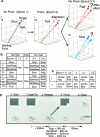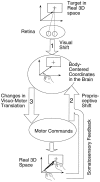Prism adaptation of reaching movements: specificity for the velocity of reaching
- PMID: 9006989
- PMCID: PMC6793717
- DOI: 10.1523/JNEUROSCI.17-04-01481.1997
Prism adaptation of reaching movements: specificity for the velocity of reaching
Abstract
Accurate reaching toward a visual target is disturbed after the visual field is displaced by prisms but recovers with practice. When the prisms are removed, subjects misreach in the direction opposite to the prism displacement (aftereffect). The present study demonstrated that the severity of the aftereffect depends on the velocity of the movements during and after the visual displacement. Trained subjects were required to reach with one of four movement durations (<300, approximately 800, approximately 2000, and approximately 5000 msec) from a fixed starting point to a target that appeared at a random location on a tangent screen (400 mm away). The size of the aftereffect was largest when the movement after the removal was performed with the same duration as that performed with the prisms. It became smaller as the difference in velocity became larger. When the contralateral arm was used after visual displacement, the aftereffect was never significant. Because the adaptation does not generalize across velocities or to the other arm, we infer that the underlying changes occur at a later stage in the transformation from visual input to motor output, in which not only the direction but also the time-dependent parameters of movements, such as velocity, acceleration or force, are represented.
Figures







Similar articles
-
Effects of delayed visual information on the rate and amount of prism adaptation in the human.J Neurosci. 1995 Nov;15(11):7644-52. doi: 10.1523/JNEUROSCI.15-11-07644.1995. J Neurosci. 1995. PMID: 7472515 Free PMC article.
-
Long-lasting aftereffects of prism adaptation in the monkey.Exp Brain Res. 2001 Nov;141(2):250-3. doi: 10.1007/s002210100892. Exp Brain Res. 2001. PMID: 11713636
-
Modulation of prism adaptation by a shift of background in the monkey.Behav Brain Res. 2016 Jan 15;297:59-66. doi: 10.1016/j.bbr.2015.09.032. Epub 2015 Sep 30. Behav Brain Res. 2016. PMID: 26431765
-
Motor adaptation to Coriolis force perturbations of reaching movements: endpoint but not trajectory adaptation transfers to the nonexposed arm.J Neurophysiol. 1995 Oct;74(4):1787-92. doi: 10.1152/jn.1995.74.4.1787. J Neurophysiol. 1995. PMID: 8989414
-
Parieto-frontal coding of reaching: an integrated framework.Exp Brain Res. 1999 Dec;129(3):325-46. doi: 10.1007/s002210050902. Exp Brain Res. 1999. PMID: 10591906 Review.
Cited by
-
Simultaneous bimanual dynamics are learned without interference.Exp Brain Res. 2007 Oct;183(1):17-25. doi: 10.1007/s00221-007-1016-y. Epub 2007 Jul 5. Exp Brain Res. 2007. PMID: 17611745 Free PMC article.
-
Asymmetric transfer of visuomotor learning between discrete and rhythmic movements.J Neurosci. 2010 Mar 24;30(12):4515-21. doi: 10.1523/JNEUROSCI.3066-09.2010. J Neurosci. 2010. PMID: 20335489 Free PMC article.
-
Visuomotor adaptation needs a validation of prediction error by feedback error.Front Hum Neurosci. 2014 Nov 4;8:880. doi: 10.3389/fnhum.2014.00880. eCollection 2014. Front Hum Neurosci. 2014. PMID: 25408644 Free PMC article.
-
Influence of movement kinematics on visuomotor adaptation.Exp Brain Res. 2016 Nov;234(11):3083-3090. doi: 10.1007/s00221-016-4707-4. Epub 2016 Jun 27. Exp Brain Res. 2016. PMID: 27349994
-
Simultaneous coordinate representations are influenced by visual feedback in a motor learning task.Annu Int Conf IEEE Eng Med Biol Soc. 2011;2011:6762-8. doi: 10.1109/IEMBS.2011.6091668. Annu Int Conf IEEE Eng Med Biol Soc. 2011. PMID: 22255891 Free PMC article.
References
-
- Ashe J, Georgopoulos AP. Movement parameters and neural activity in motor cortex and area 5. Cereb Cortex. 1994;6:590–600. - PubMed
-
- Baily JS. Adaptation to prisms: do proprioceptive changes mediate adapted behaviour with ballistic arm movements? Q J Exp Psychol. 1972;24:8–20. - PubMed
-
- Bizzi E, Mussa-Ivaldi FA, Giszter S. Computations underlying the execution of movement: a biological perspective. Science. 1991;253:287–291. - PubMed
-
- Cheney PD, Fetz EE. Functional classes of primate cortico-motoneuronal cells and their relation to active force. J Neurophysiol. 1980;44:773–791. - PubMed
-
- Flament D, Hore J. Relations of motor cortex neural discharge to kinematics of passive and active elbow movements in the monkey. J Neurophysiol. 1988;60:1268–1284. - PubMed
MeSH terms
LinkOut - more resources
Full Text Sources
Medical
